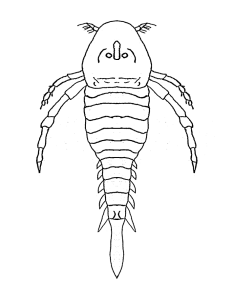A Catskills fossil monster
The Catskill Geologists; The Mountain Eagle; April 2018
Robert and Johanna Titus
In our earlier lives, the two of us were very fond of Japanese sci-fi movie monsters. You probably remember Godzilla and Rodan, don’t you? And so it was a pleasant surprise for us to find out that the Catskills have their own monster. It’s not alive today; it dates back to the Devonian time period. Our Catskills monster has never been in a movie, not even a Japanese one. One of its cousins did achieve fame as the New York State fossil. It has, however, found a place for itself in the scientific literature. And it has received prominent placement in at least one museum. Scientifically, it is of some importance as a fossil.
Our ancient monster, in life, would have reminded you of a scorpion. That is, except for one thing; our monster was at least 40 inches long. Well, perhaps that does not make it a true monster, but it was a pretty big scorpion. The animal belongs to a group of invertebrate animals called the eurypterids. They are indeed distant cousins of scorpions. The common name for a eurypterid is the sea scorpion. That’s a bit of a misnomer as many, if not most of them, lived in freshwater habitats. Our Catskills monster has a proper scientific name; it is Hallipterus excelsior.
This monster was discovered in the western Catskills in the 1880’s. It was found in an old quarry in the village of Andes. The only part of it that was found was the head. But that alone, was ten inches long. The rest of the creature in our picture is a reconstruction by an artist named Nobu Tamura. That reconstruction is based on the study of a number of other, better-preserved eurypterids.

We can speculate that our monster lived in one of the many streams that crisscrossed the Devonian Catskill Delta, perhaps 385 million years ago. If you have been reading our columns then you know that the Catskill Mountains are a large petrified delta, comparable, in size, to the Ganges River Delta of Bangladesh. If you get out a good map of the Ganges Delta, you will find it has many fairly sizable rivers flowing across it. If we could drop living eurypterids into any of these rivers then they would quite possibly do well as invasive species.
Cousins of Hallipterus have long, well-developed claws. Those may well have been predators. Hallipterus, itself, does not have such claws. We can guess that it might have been a scavenger. Eurypterids are quite likely to have competed for dominance in their streams with our own ancestors – the fish. Fish lived in the rivers of the Catskill Delta too. Some of them would soon evolve into primitive amphibians, founders of a lineage that would eventually lead to the mammals – and us. Had evolution been a little kinder to the eurypterids, then it might have been their descendants that, today, would be reading the Mountain Eagle.
One of us, Robert, went to school with the Andes monster. That fossil was obtained by a Rutgers student, soon after its discovery. He gave the specimen to the museum at the Rutgers geology building. When Robert took introductory geology, the class was in the museum and he found himself seated next to the monster.
Contact the authors at randjtitus@prodigy.net. Join their facebook page “The Catskill Geologist.” Read their blog at “the catskillgeologist.com.”





